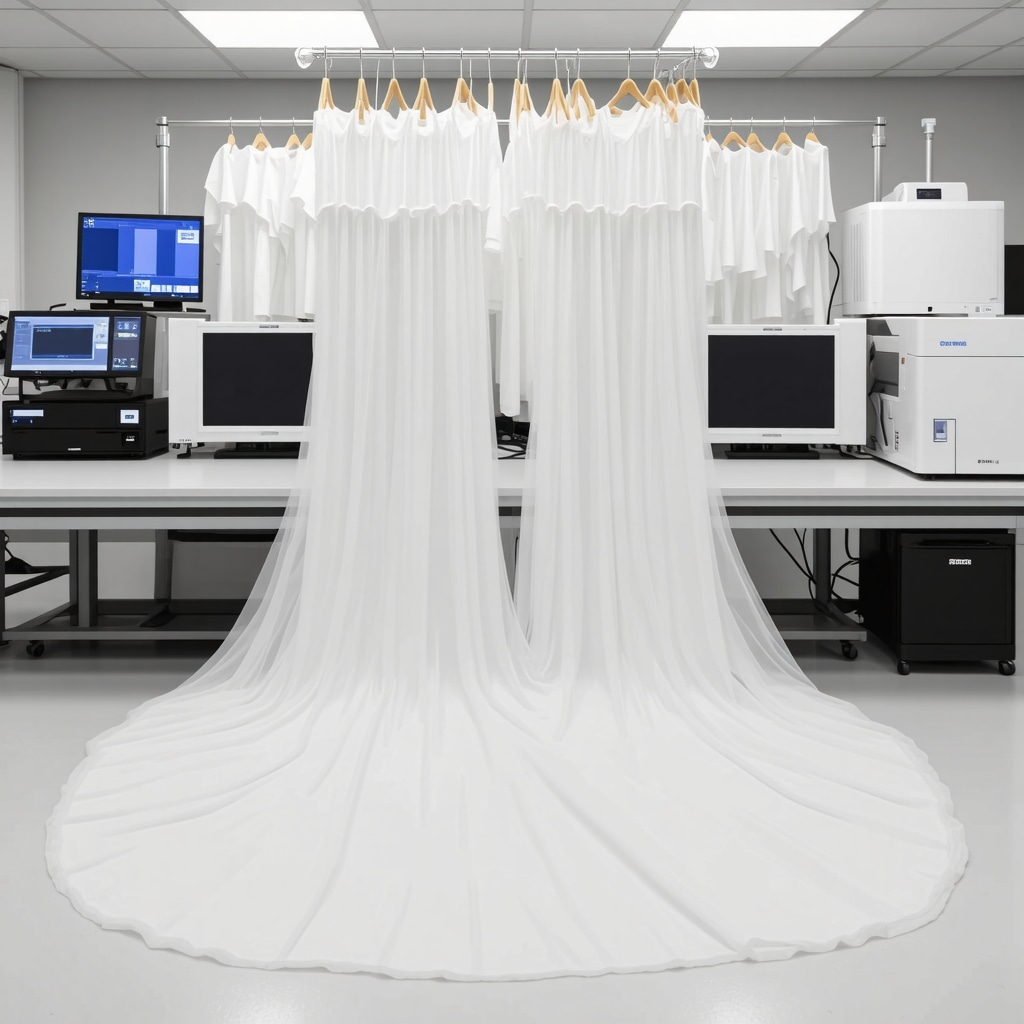Elevating Bridal Gown Preservation to Museum Standards in Tampa Bay
Preserving a bridal gown at museum quality transcends basic cleaning; it demands a nuanced understanding of textile science, environmental controls, and advanced conservation techniques. In Tampa Bay, where humidity and heat pose unique challenges, achieving long-lasting preservation requires expert intervention that combines local climate considerations with state-of-the-art preservation methodologies.
Advanced Textile Conservation: Protecting Delicate Fabrics Against Tampa Bay’s Humidity
Humidity-induced deterioration is a principal concern for bridal gowns stored in Tampa Bay. Silk, lace, and tulle—common fabrics in bridal couture—are particularly vulnerable to mold, mildew, and yellowing under prolonged exposure to moisture. Museum-quality preservation employs acid-free, lignin-free archival boxes and buffered tissue paper to neutralize environmental acidity and inhibit fabric degradation. Moreover, climate-controlled storage with regulated temperature and humidity levels (ideally 65°F and 50% relative humidity) is critical to maintain textile integrity over decades.
What specialized cleaning processes are essential before preservation to ensure fabric longevity?
Pre-preservation cleaning is an indispensable step that demands precision. Bridal gowns often harbor invisible oils, perspiration, and organic stains that, if untreated, catalyze fiber breakdown. Expert cleaners in Tampa Bay utilize gentle, solvent-free wet cleaning methods tailored for delicate fibers, coupled with enzymatic stain removers that target proteins and tannins without compromising fabric dyes or embellishments. This process aligns with recommendations from the American Institute for Conservation, endorsing non-invasive and reversible treatments (source: AIC Textile Conservation Guidelines).
Integrating Eco-Friendly Preservation Strategies with High-Performance Results
Emerging preservation protocols in Tampa Bay emphasize sustainable practices without sacrificing efficacy. Utilizing eco-friendly detergents free from harsh chemicals reduces environmental impact and protects sensitive gown materials from aggressive agents that traditional solvents might impose. Additionally, UV-filtering storage containers and breathable fabric covers safeguard against light-induced fading, a subtle but irreversible form of damage often overlooked in conventional gown care.
Understanding the Role of Professional Expertise in Bridal Gown Preservation
Local Tampa Bay preservation specialists combine decades of textile conservation experience with tailored services that address the specific challenges posed by the region’s climate. Their expertise encompasses stain identification, fiber analysis, and custom packaging solutions designed to prevent mechanical stress and fabric distortion. Engaging professionals ensures adherence to museum-grade standards, safeguarding the gown as a cherished heirloom.
For brides seeking to maintain their gown’s pristine condition while embracing Tampa Bay’s unique environmental factors, exploring expert preservation guides offers invaluable insights.
Call to Action: Share Your Expertise or Discover More Advanced Preservation Techniques
We invite textile conservators, bridal experts, and Tampa Bay brides to contribute their own experiences or questions regarding museum-quality bridal gown preservation. Delve deeper into specialized preservation secrets curated by local professionals to extend the lifespan and legacy of your wedding dress.
Innovative Storage Solutions: Beyond Traditional Archival Boxes
While acid-free boxes and buffered tissue paper remain the gold standard for bridal gown preservation, evolving storage technologies are offering enhanced protection against Tampa Bay’s persistent humidity and temperature fluctuations. Vacuum-sealed storage systems with integrated silica gel packets help maintain a microenvironment that mitigates moisture accumulation and inhibits microbial growth. Additionally, breathable, archival-quality garment bags constructed from non-woven polypropylene fabrics allow airflow while preventing dust and insect damage, which is crucial in Tampa’s subtropical environment.
Customizing Preservation Protocols for Different Bridal Gown Fabrics
Not all bridal gowns are created equal. Each fabric type requires tailored conservation techniques to optimize longevity. For example, silk charmeuse demands gentle wet cleaning with pH-neutral detergents, whereas organza benefits from low-temperature drying processes to prevent fiber distortion. Lace often requires hand-spotting with enzyme-based stain removers due to its intricate patterns and delicate threads. Expert conservators in Tampa Bay adapt these protocols based on a thorough fabric analysis, ensuring each gown receives personalized care that respects its unique composition and embellishments.
How can Tampa Bay brides balance eco-conscious preservation with maintaining their wedding dress’s pristine condition?
Balancing sustainability with effective gown care is an increasingly pertinent question for environmentally aware brides. The answer lies in selecting cleaning agents and storage materials that align with green principles without compromising fabric integrity. Biodegradable detergents free from phosphates and optical brighteners reduce ecological footprint while preventing chemical residue buildup on delicate textiles. Moreover, opting for reusable, recyclable packaging materials such as acid-free cotton muslin bags instead of plastic supports sustainability goals. Tampa Bay’s local experts often recommend eco-friendly wedding dress care solutions that harmonize environmental responsibility with museum-quality preservation standards.
Mitigating the Impact of Tampa Bay’s UV Exposure on Bridal Fabrics
Sunlight, especially ultraviolet (UV) rays, accelerates photodegradation of bridal gown textiles, causing yellowing and fiber weakening. In Tampa Bay, where intense sunlight is prevalent year-round, it is critical to integrate UV-blocking measures into preservation routines. Using UV-filtering glass or acrylic display cases and storing gowns in darkened, climate-controlled environments significantly curtail light-induced damage. Additionally, fabrics treated with UV-absorbing agents during cleaning can gain an extra layer of protection, extending the aesthetic and structural lifespan of the gown.
These advanced preservation strategies are underscored by the Textile Conservation Centre’s research on light damage prevention, which highlights the importance of controlled illumination and protective coatings in prolonging fabric durability (source: Textile Conservation Centre, University of Oxford).
Partnering with Tampa Bay’s Leading Bridal Gown Preservation Professionals
Choosing a local expert skilled in museum-grade bridal gown preservation ensures tailored care that addresses Tampa Bay’s environmental challenges. Professionals provide detailed condition reports, recommend customized cleaning and storage regimens, and offer restoration services for minor fabric damages. Their expertise facilitates maintaining your gown’s pristine condition for generations to come. For an in-depth understanding of expert services available, explore our comprehensive guide on expert wedding gown preservation in New Tampa.
Engage with Us: Share Your Preservation Challenges and Discover Expert Solutions
We welcome Tampa Bay brides, textile conservators, and wedding professionals to share their experiences or ask questions regarding bridal gown preservation in humid climates. Your contributions enrich our community knowledge base and help refine best practices tailored to local conditions. To learn more about effective stain removal techniques and sustainable cleaning options, consider visiting our detailed resources on wedding dress stain removal in Tampa and eco-friendly wedding dress care in Tampa. Feel free to contact us with your inquiries or preservation stories.
Decoding the Chemistry Behind Bridal Gown Fabric Degradation in Tampa Bay’s Climate
Understanding the molecular interactions that lead to bridal gown deterioration is critical for developing effective preservation strategies tailored to Tampa Bay’s subtropical environment. Natural fibers such as silk and cotton contain amino acids and cellulose chains susceptible to hydrolysis and oxidation when exposed to elevated humidity and temperature fluctuations prevalent in this region. These chemical reactions can cause fiber weakening, discoloration, and brittleness over time. Additionally, residual detergents or stains may catalyze acid-catalyzed hydrolysis, accelerating decay. Consequently, preservation experts emphasize rigorous pre-treatment protocols and environmental stabilization to halt these degradative pathways, aligning with findings from peer-reviewed textile conservation studies (source: Journal of the American Institute for Conservation).
Harnessing Nanotechnology for Enhanced Protective Coatings in Bridal Gown Preservation
Recent advancements in nanotechnology have opened new avenues for textile conservation, offering microscopic protective layers that reinforce fabric resilience without altering tactile qualities. Nano-coatings can impart hydrophobic and antimicrobial properties, preventing moisture ingress and inhibiting mold proliferation—two primary concerns in Tampa Bay’s humid climate. These ultra-thin films are designed to be reversible and non-toxic, adhering to conservation ethics. Integrating such innovations requires collaboration with specialized laboratories and conservators trained in applying these treatments, ensuring gowns retain their original aesthetic and structural integrity while gaining superior environmental resistance.
Can nanotech applications be safely integrated into traditional bridal gown preservation workflows without compromising authenticity?
The integration of nanotechnology in gown preservation remains a nuanced subject. While laboratory tests demonstrate promising protective benefits, conservators exercise caution to preserve historical authenticity and reversibility—core museum standards. Current protocols recommend pilot testing on inconspicuous gown sections and comprehensive documentation to monitor long-term effects. Tampa Bay specialists are pioneering controlled trials to balance technological benefits with ethical imperatives, offering brides cutting-edge solutions that respect their gown’s provenance and value.
Optimizing Microclimate Control: Sensor-Driven Smart Storage Systems for Bridal Gowns
Smart storage solutions leveraging IoT-enabled sensors represent the frontier of environmental control for textile preservation. These systems continuously monitor temperature, humidity, light exposure, and airborne pollutants within storage enclosures, automatically adjusting conditions to optimal setpoints. In Tampa Bay, where rapid weather changes can disrupt static environments, such dynamic regulation is invaluable. Alerts and data logging enable conservators and owners to respond proactively to environmental deviations, mitigating risks before irreversible damage occurs. Implementing these systems requires investment but yields unparalleled protection, aligning with best practices in contemporary conservation science.
Collaborative Networks: Bridging Tampa Bay Brides with Textile Science and Conservation Expertise
Fostering dialogue between brides, conservators, and textile scientists enhances preservation outcomes by integrating practical experience with empirical research. Tampa Bay’s preservation community is increasingly engaging through workshops, webinars, and forums to disseminate advanced knowledge and tailor solutions to local climatic challenges. This collaborative approach democratizes access to museum-grade preservation techniques, empowering brides to make informed decisions about their gown’s care. Furthermore, ongoing research partnerships drive innovation, ensuring Tampa Bay remains at the forefront of bridal gown conservation.
For brides committed to safeguarding their wedding dress legacy, exploring advanced preservation strategies curated by Tampa Bay experts is an essential step toward achieving enduring beauty and heritage.
Exploring the Intersection of Biochemical Stability and Preservation Efficacy
Delving deeper into the molecular dynamics at play, preservation specialists in Tampa Bay are leveraging advanced spectroscopic analysis to monitor fabric degradation pathways in real-time. Techniques such as Fourier-transform infrared spectroscopy (FTIR) and Raman spectroscopy enable precise identification of oxidative and hydrolytic damage markers within silk and cotton fibers. This granular insight facilitates the customization of preservation treatments tailored to arrest chemical decay before it manifests visually, thereby extending the gown’s lifespan beyond traditional expectations.
Augmenting Preservation with Controlled Atmosphere Packaging
Innovative use of controlled atmosphere packaging (CAP) is gaining traction among Tampa Bay conservators. By manipulating oxygen and humidity levels within hermetically sealed enclosures, CAP effectively suppresses microbial activity and enzymatic reactions responsible for fabric deterioration. This technology, inspired by food preservation methodologies, adapts well to textile conservation, offering a chemically inert microenvironment that complements existing archival materials. Customizable CAP solutions are particularly advantageous for long-term storage in Tampa’s fluctuating subtropical climate.
How do controlled atmosphere strategies integrate with existing museum-grade bridal gown preservation techniques?
Integrating CAP with traditional preservation protocols requires a synergistic approach. Experts recommend initial thorough cleaning and stabilization of the gown, followed by packaging in acid-free materials within CAP systems calibrated to optimal oxygen and humidity thresholds. Continuous environmental monitoring ensures these parameters remain stable, preventing oxidative stress and microbial proliferation that could compromise delicate fibers. Tampa Bay’s climate-specific applications underscore the importance of combining CAP with climate-controlled storage rooms to maximize efficacy, as detailed in the American Institute for Conservation resources.
Leveraging Artificial Intelligence for Predictive Textile Conservation
Emerging AI-driven models are revolutionizing preservation by forecasting degradation risks based on environmental data and historical gown conditions. Tampa Bay preservationists are beginning to employ machine learning algorithms that analyze sensor inputs—such as microclimate fluctuations and pollutant exposure—to predict potential fabric vulnerabilities. These predictive insights enable preemptive interventions, optimizing resource allocation and minimizing irreversible damage. The integration of AI with IoT sensor networks epitomizes the future of smart, responsive conservation tailored to Tampa Bay’s unique environmental challenges.
Advanced Photoprotective Molecular Treatments: Beyond UV-Filtering
Beyond mechanical UV barriers, chemical photoprotectants incorporating molecular absorbers and radical scavengers are under experimental application. These treatments form a dynamic defense against photochemical degradation by neutralizing free radicals generated by UV exposure, a critical advancement for Tampa Bay gowns frequently subjected to intense sunlight. While still emerging, these molecular coatings maintain fabric aesthetics and flexibility, aligning with conservation ethics of reversibility and minimal intervention.
Call to Action: Embrace Next-Level Preservation Innovations for Your Bridal Heirloom
For Tampa Bay brides and textile conservation professionals eager to pioneer these sophisticated preservation modalities, we encourage engagement with local experts and participation in upcoming workshops focusing on nanotechnology, controlled atmosphere packaging, and AI-driven conservation analytics. Elevate your bridal gown’s legacy by adopting cutting-edge, scientifically validated preservation strategies tailored specifically for Tampa’s climatic intricacies. Connect with our network today to explore collaborative opportunities and expert consultations.

Expert Insights & Advanced Considerations
Integrating Nanotechnology with Ethical Textile Conservation
The application of nanotech protective coatings in bridal gown preservation offers hydrophobic and antimicrobial benefits that significantly extend fabric longevity in Tampa Bay’s humid climate. However, conservators must prioritize reversibility and authenticity, performing controlled tests and thorough documentation to maintain museum-grade standards.
Smart Storage Systems as a Proactive Preservation Strategy
IoT-enabled microclimate monitoring and adaptive control systems provide dynamic environmental regulation crucial for Tampa’s fluctuating conditions. These technologies enable rapid response to humidity and temperature deviations, reducing risk of fiber degradation and microbial growth while facilitating data-driven conservation decisions.
Customized Conservation Protocols Based on Molecular Fiber Analysis
Advanced spectroscopic techniques such as FTIR and Raman spectroscopy allow precise identification of oxidative and hydrolytic damage at the molecular level. Tailoring cleaning and stabilization treatments according to these insights enhances preservation efficacy and prevents early-stage chemical decay invisible to the naked eye.
Synergistic Use of Controlled Atmosphere Packaging (CAP)
CAP systems, by regulating oxygen and humidity within hermetic enclosures, complement acid-free archival materials and climate-controlled storage. This layered approach effectively suppresses microbial activity and oxidative reactions, offering an optimized microenvironment suited to Tampa Bay’s subtropical challenges.
Balancing Eco-Friendly Practices with High-Performance Preservation
Selecting biodegradable detergents and recyclable packaging supports sustainability goals without compromising fabric integrity. Eco-conscious brides can achieve museum-quality preservation by collaborating with local experts familiar with green cleaning agents and breathable, UV-filtering storage solutions designed for sensitive textiles.
Curated Expert Resources
American Institute for Conservation (AIC) Textile Conservation Guidelines: Comprehensive standards and ethical protocols for textile preservation, emphasizing reversible and non-invasive treatments essential for museum-grade care (AIC Textile Conservation Guidelines).
Textile Conservation Centre, University of Oxford: Authoritative research on photodegradation and textile preservation techniques, offering insights into UV damage prevention and advanced protective coatings (Textile Conservation Centre).
Journal of the American Institute for Conservation: Peer-reviewed studies on biochemical degradation mechanisms of natural fibers, underpinning scientifically grounded preservation strategies (JSTOR – AIC Journal).
Local Tampa Bay Preservation Professionals: Practitioners combining regional climate expertise with museum-grade methods, offering tailored services and advanced guidance (Bridal Gown Preservation Secrets for Tampa Weddings).
Eco-Friendly Wedding Dress Care in Tampa: Resource for sustainable cleaning and storage solutions harmonizing environmental responsibility with high-level textile protection (Eco-Friendly Wedding Dress Care Tampa).
Final Expert Perspective
Preserving bridal gowns to museum-quality standards in Tampa Bay demands a multidimensional approach that blends advanced scientific techniques with regionally informed expertise. From nanotechnology-enhanced coatings and smart sensor-driven storage to eco-conscious cleaning protocols, each innovation addresses the unique challenges posed by Tampa’s humid, UV-intense environment. Integrating molecular diagnostics with controlled atmosphere packaging ensures that gowns retain their structural integrity and aesthetic brilliance for generations.
For brides and conservation professionals alike, embracing these sophisticated strategies not only safeguards a cherished heirloom but also elevates preservation to an art and science. To deepen your understanding and access expert services tailored to Tampa Bay’s climate, explore our detailed guides on bridal gown preservation secrets and connect with trusted local specialists at Contact Us. Engage with the forefront of museum-quality bridal gown preservation and secure your gown’s legacy with confidence.


I recently worked with a Tampa-based textile conservator who emphasized the importance of meticulous pre-treatment before storage. It’s fascinating how much subtle damage, like micro-mildew or residual stains, can occur without immediate visible signs, especially given Tampa Bay’s high humidity. I’ve found that incorporating both environmentally controlled storage and UV-protective measures really extends the gown’s life. One challenge I’ve encountered is ensuring that eco-friendly cleaning agents are effective enough without compromising the fabric’s delicate fibers. Has anyone here experimented with different green cleaning products, and what has been your experience in balancing sustainability and preservation quality? It seems this combination is vital for maintaining the gown’s aesthetic and structural integrity long-term.